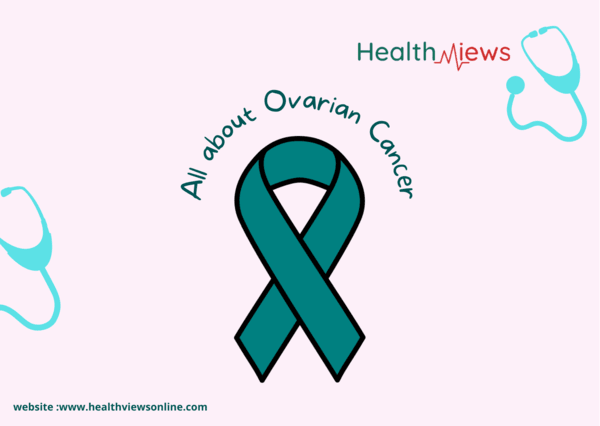What is Ovarian cancer?
Ovarian cancer is a type of cancer that develops in the ovary’s tissues. Ovarian cancer begins in the ovaries, which are small organs in the female reproductive system that produce eggs. It develops when abnormal cells in your ovaries or fallopian tubes multiply uncontrollably.
Two ovaries, one on each side of the uterus, make up the female reproductive system. The hormones estrogen and progesterone, as well as eggs (ova), are produced by the ovaries, which are about the size of an almond.
A pair of reproductive organs in women are called ovaries. One is on either side of the uterus in the pelvis (the hollow, pear-shaped organ where a fetus grows). The size and form of each ovary are similar to an almond.
Also Read: Cervical Cancer: Symptoms, Causes, Risk Factors, Diagnosis, Prevention, Facts
Types of Ovarian Cancer
Ovarian cancers are classified into three types, each named after the tissue in which they are found.
- Epithelial cell cancer: These cancers grow from cells that line the ovary’s surface. The majority of ovarian cancers are epithelial cell cancers.
The following two closely related epithelial cancers can also spread to the ovaries:
- Fallopian tube cancer: The tissue lining a fallopian tube is where fallopian tube cancer develops. On either side of the uterus, there are two long, narrow tubes known as the fallopian tubes. The female reproductive system houses the uterus, which is where a baby develops during pregnancy.
- Primary Peritoneal cancer: The peritoneum’s lining tissue is where primary peritoneal cancer develops. Your peritoneum is the tissue lining that protects the abdominal organs (belly).
- Germ cell cancer: This type of cancer forms from the cells in the ovary that produce eggs.
- Stromal cell cancer: These cancers form in the cells of the ovary’s structural tissue, which is responsible for the production of female hormones. Sources
What are the causes?
The precise cause of ovarian cancer is unknown. The majority of ovarian cancers are caused by genetic changes that occur throughout your life. However, these genetic changes can be inherited, which means you are born with them. However, some people are at a slightly increased risk of developing the condition. Age is the main risk factor for the majority of cancers. The chance of developing cancer rises with age. Source
Risk factors
A woman’s chances of having the condition may increase due to a few risk factors. Risk elements consist of:
- Being over 60 years old.
- Obesity.
- Having ovarian cancer runs in your biological family, having inherited a gene mutation (BRCA1 or BRCA2), or having Lynch syndrome.
- Lately married or having kids later in adulthood.
- Endometriosis.
- Replacement hormone treatment
- Infertility (inability to become pregnant)
- Personal experience with colon or breast cancer
- Certain fertility drugs Source
Symptoms
It’s possible that ovarian cancer does not first manifest any symptoms. When ovarian cancer symptoms appear, they are frequently mistaken for those of other, more common infections.
- Discomfort or bloating in the abdomen or pelvis.
- Weight loss
- Alterations in eating patterns, early fullness, and loss of appetite.
- Fatigue
- Backache
- Alterations in bowel habits, like constipation
- A persistent urge to urinate
- Vaginal discharge or unusual bleeding, particularly if it happens outside of your regular menstrual cycle or after menopause.
- A growth in your abdomen’s size.
- Peeing more frequently (frequent urination).
Diagnosis
Despite years of research, no successful ovarian cancer screening test has been developed. As a result, the condition is frequently difficult to diagnose in its early stages.
If your physician suspects you may have ovarian cancer, They
- Will inquire about your health background, including your current symptoms..
- Will inquire about your family’s medical history, including relatives with ovarian cancer.
- Will do a physical assessment that includes a pelvic exam
- Imaging tests will most likely be performed.
- Blood tests, such as the CA-125 blood test, may be performed.
- A biopsy of the tissue is often the only way to be certain that you have ovarian cancer. During surgery to remove the tumor, a biopsy is performed.
Treatment
Ovarian cancer treatments may include:
- Surgery
- Chemotherapy
- Targeted therapy
- Hormone Therapy
- Radiation Therapy
- Genetic testing
After you’ve finished ovarian cancer treatment, your doctor will want to see you on a regular basis for observation. You may be required to attend routine check-ups to ensure that cancer has not returned over time. Source
When to see a doctor
Schedule an appointment with a healthcare provider if you notice unusual lumps, pain, or bloating in your abdomen.
If you’ve been diagnosed with ovarian cancer, you should ask your doctor the following questions:
- What can I expect if I am identified with ovarian cancer?
- What is the survival rate for ovarian cancer?
- Is cancer spreading? If so, how far is it?
- What treatments do you suggest?
- How long will it take for my treatment to be completed?
- Can I continue working while receiving treatment?
- Are there any ovarian cancer resources?
Can Ovarian cancer be prevented?
It cannot be prevented, although there are some factors that are linked to a lower risk of developing it. However, being aware of your biological family history might help you be ready for any potential increased risk of this cancer. Your healthcare practitioner might advise risk-reducing surgery to remove your ovaries and tubes before they develop cancer and for at least five years, using birth control tablets.
Also Read: Thyroid Cancer: Symptoms, Causes, Risk Factors, Diagnosis, Prevention, Facts





